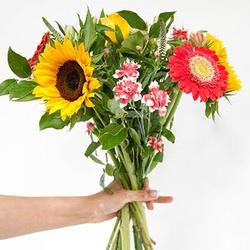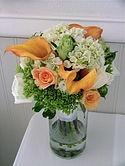Help your cut flowers live longer
-
Whether you cut flowers from your own garden or purchase cut flowers, the following advice applies:
- When cutting flowers, do so early in the morning before the temperature rises. The flowers will be filled with moisture and last much longer. If you absolutely cannot cut your garden flowers in the early morning, wait as long as possible at the end of the day when the weather has cooled and the flowers have had time to reenergize and absorb moisture.
 Photo: Flying Flowers
Photo: Flying Flowers - Take a bucket of water with you into the garden and plunge the stalks immediately into the water.
- Recut all flowers before placing them in an arrangement. Fill a large bowl with tepid water. Place the flower stem in the water and make a new cut under water for each stem. Make the cut on a sharp angle. The goal is to expose as much stem to water as possible. Making the cut under water allows water to be drawn up the stem and helps to eliminate any small air bubbles that may restrict the flow of water.
- Remove all foliage that will be below the water line.
- If you purchased your bouquet, there was probably a little packet of “flower food” tucked into your purchase. Use it! The ingredients will vary, but the major components include: a sugar, an acid, and an anti-bacterial (also known as a biocide). Each provides valuable resources to prolong the life of your arrangement. Sugar provides food energy to the stem; the acid helps the water move up the stem more easily; and the anti-bacterial agent attempts to control the growth of bacteria on the stalk, in the water, and in the overall arrangement. DIY floral food: Steven Brown, Chair for the Environmental Horticulture/Floristry Department at SF City College recommends a 1:1:10 solution – 1 part lemon-lime soda (acid and sugar), 1 part bleach, and 10 parts water.
- Refresh the water in the vase every two days. This is considered to be the number one most effective advice to extending the life of cut flowers.
- When the arrangement you have is just perfect, it’s hard to think about removing it from the container to refresh the water. Try holding the arrangement in your hand, tie a ribbon around it to keep everything in its place, then remove it from the container while you thoroughly clean and refill the container with water and preservative. While the bouquet is tied, place it in a large container of water and recut the stems under water. You will be well rewarded for your efforts!
Some tips on working with popular cut flowers: Photo: Jane Scurich
Photo: Jane Scurich- Daffodils and narcissus excrete a milky compound that restricts the flow of water to other flowers. Plan arrangements of daffodils on their own or place them in a separate container within a larger arrangement.
- Tulips and anemones continue to grow after they are cut! Prepare for their stems to become longer when you are selecting a container.
- Lilies are wonderfully easy to grow, often available for purchase, and offer a long container life. In your cutting garden, resist the temptation to cut flowers from first-year growth. If you cannot possibly resist the temptation to cut the lilies, leave a long stem in the ground to allow the bulbs to multiply and provide many flower stems the following year.
- Lily pollen can permanently stain clothing and furniture. Use your fingertips or small scissors to carefully remove the pollen-coated anthers at the end of the stamens.
- Clematis can be fabulous additions to arrangements. Recut them under water at a sharp diagonal with a knife, not clippers. Allow their stems to be free in arrangements -- no oasis or frogs to inhibit their slender stems.
- Both hellebores and poppies need to have cut ends seared with a flame before they are placed in a vase. A hand-held fire starter is great for this job.
- To insure the stems of Gerbera daisies remain upright, keep the water level very high. Making a tiny pinprick just under the blossom will help water flow up the stem. Alternately, insert the stem in a clear plastic drinking straw for support.
- Hydrangeas are often readily available in our gardens. Use a small hammer to crush the ends of the woody stem to expose more flesh to the water.
- Cut flowers are often available just as you enter the market. While it’s tempting to select them immediately, cruise the aisles for all your nonperishable items and pick up the bouquets just before the ice cream on your shopping list. The less time the stems are out of water, the better.
- All arrangements will benefit by not being placed in direct sunlight or near a heat source. Moving your container to a cooler space when you aren’t at home or overnight will also help to keep your blossoms colorful and fresh looking longer.
- And that water line around your glass vase that just won’t go away? Extra strength denture cleanser tablets to the rescue!
By Jane Scurich


